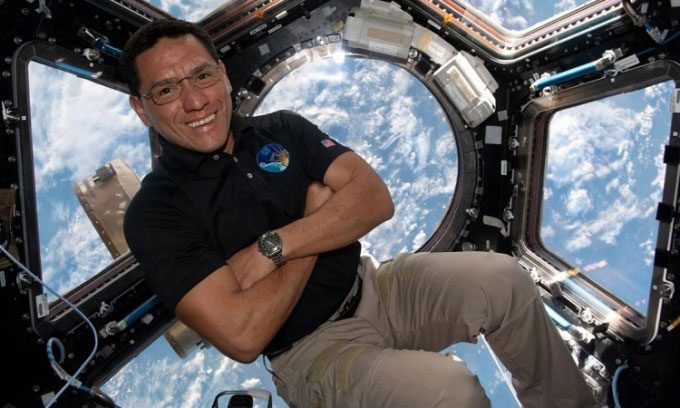Frank Rubio is set to become the longest-serving American astronaut in space if he returns to Earth aboard a Russian Soyuz spacecraft in six months.
Initially, Astronaut Frank Rubio traveled to the International Space Station (ISS) on September 21, 2022, for a six-month mission. However, he will spend over a year in space, breaking the record for the longest mission by an American astronaut. Rubio is scheduled to return to Earth on the Soyuz spacecraft as early as September 27, according to NASA’s announcement on March 29, meaning he will spend a total of at least 371 days in orbit, surpassing the previous record of 355 days set by American astronaut Mark Vande Hei in 2022.

NASA astronaut Frank Rubio captured this image by the dome window of the ISS as it passed over southeastern England at an altitude of 423 km. (Photo: NASA).
Initially, Rubio’s return flight was scheduled for spring this year. However, the spacecraft carrying Rubio and his two Russian colleagues, Sergey Prokopiev and Dmitry Petelin, developed a coolant leak last December. Authorities from Russia’s space agency, Roscosmos, subsequently concluded that the spacecraft was not safe enough to bring the astronauts home. Instead, the Soyuz MS-22 returned to Earth without a crew on March 28. Roscosmos launched a replacement spacecraft, MS-23, which docked with the ISS on February 23.
If everything goes as planned and Rubio departs on September 27, his 371 days in space will not be a world record. The late Russian astronaut Valeri Polyakov still holds the record with 437 consecutive days aboard the Russian space station Mir from mid-1994 to 1995.
Vande Hei held the record for the longest time spent in space by an American astronaut last year after NASA and Roscosmos decided to extend his mission. Russia sent a two-person film crew to the ISS, delaying Vande Hei’s return flight. Before Vande Hei, American astronaut Scott Kelly set the record with a 340-day mission, designed by NASA to study the long-term effects of space travel on the human body.
Rubio traveled to the ISS on a Russian spacecraft as part of a crew exchange agreement between NASA and Roscosmos in the summer of 2022. NASA officials assigned Rubio to fly on Soyuz MS-22 while Roscosmos arranged for astronaut Anna Kikina to fly on SpaceX’s Crew Dragon in October 2022, returning to Earth on March 11, 2023.
NASA emphasized that the agreement with Russia is crucial to ensure the continuous safe operation of the ISS. If either the Russian Soyuz or SpaceX’s Crew Dragon encounters issues and cannot operate, the exchange agreement will ensure that both American and Russian astronauts can still access the ISS.


















































